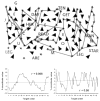Disorganized search on cancellation is not a consequence of neglect
- PMID: 15249614
- PMCID: PMC4441794
- DOI: 10.1212/01.wnl.0000131947.08670.d4
Disorganized search on cancellation is not a consequence of neglect
Abstract
Background: Some studies have suggested that in stroke patients, spatial inattention on the cancellation test is closely related to disorganized visual search. However, methods to assess spatial aspects of search organization on cancellation tests have not been well developed. In this study the authors design and evaluate new methods to quantify strategies of spatial exploration on the cancellation test in stroke patients who showed a broad range of spatial attentional abilities, and test whether disorganization and inattention are related.
Methods: Twenty stroke patients were videotaped while they performed a cancellation test. Several variables that reflect spatial aspects of search organization were measured through subsequent video playback. Two patients with severe neglect were excluded from further analysis to avoid constraining the spatial expression of search organization. Spearman correlations were used to assess whether severity of spatial inattention correlated with the individual search organization measures.
Results: Of the 18 remaining patients, 10 had mild-moderate spatial neglect (pathologic inattention), while the other 8 omitted at most one target (normal performance). There were no significant correlations between the number of targets omitted and any of the search organization measures.
Conclusions: Spatial inattention on cancellation due to neglect following stroke is not closely related to the organization of visual search. Instead, search disorganization during cancellation may reflect disturbance of an unspecified executive control mechanism.
Figures


References
-
- Halligan PW, Marshall JC, Wade DT. Visuospatial neglect: underlying factors and test sensitivity. Lancet. 1989;ii:908–911. - PubMed
-
- Agrell BM, Dehlin OI, Dahlgren CJ. Neglect in elderly stroke patients: a comparison of five tests. Psychiatry Clin Neurosci. 1997;51:295–300. - PubMed
-
- Fullerton KJ, McSherry D, Stout RW. Albert’s test: a neglected test of perceptual neglect. Lancet. 1986;i:430–432. - PubMed
-
- Fullerton KJ, MacKenzie G, Stout RW. Prognostic indices in stroke. Q J Med. 1988;66:147–162. - PubMed
-
- Friedman PJ. The Star Cancellation Test in acute stroke. Clin Rehabil. 1992;6:23–30.
Publication types
MeSH terms
Grants and funding
LinkOut - more resources
Full Text Sources
